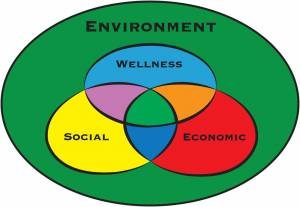Welcome to Bemidji State University
Here at Bemidji State University, sustainability is emphasized in the classroom and across campus. The following self-guided tour features many aspects which exemplify our campus’ commitment to sustainability. If you are unable to visit campus in person, we invite you to watch this 60-minute video tour featuring many of the same stops. Neither tour fully captures the entirety of our university’s efforts to reduce its carbon footprint and increase its resilience. Yet, both provide a nice overview of these efforts.
BSU approaches sustainability through a unique model, shown below and explained in the video, which incorporates a personal wellness component and emphasizes the environment as all-encompassing. We encourage you to consider this altered triple bottom line as you progress through the tour.
BSU’s Sustainability Model
Map
Tour Stops
1. American Indian Resource Center (AIRC)
Start at the American Indian Resource Center near the football field. You can park in the AIRC parking lot (free parking in the summer and after 6:00pm during the academic year; call 218-755-2032 to confirm).
BSU is situated on original Ojibwe territory and is surrounded by Minnesota’s three largest Tribal Nations – Red Lake to the north, White Earth to the southwest, and Leech Lake to the southeast. BSU’s vision of sustainability is intimately related to Native American culture and perspective. BSU’s sustainability model is inspired by the Anishinaabe creation story, where the Creator created the world in a certain order. Humans were created last and are dependent on animals, plants and Mother Earth to survive, yet nothing is dependent on humans. Humans need nature to survive and thrive.
Can you think of one way in which Native Americans practiced sustainable methods?
2. White Pine Arch
From the AIRC walk south east towards the entrance of the football field, here you will see the Wooden Arch.
In 2013, the University decided to replace the stadium turf and in the process had to remove three large white pines that flanked the field. Sections of the tree were saved and various projects became of them, including this stadium arch, a project coordinated by the Beaver Engineering and Design Club.
Why would sourcing local wood be sustainable?
3. Gitigaan Garden
From the football field walk to Birchmont Drive, then south (left) on Birchmont Drive. At the cross walk near Benson Hall cross the street, at 16th St., to the west side of the road. The Gitigaan Garden will be straight ahead.
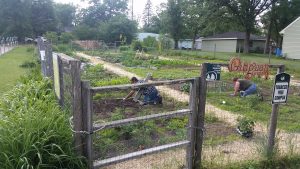
Gitigaan is Ojibwe for garden. The garden is open to students, faculty, and staff, as well as community members for the small price of $5 for students and $10 for all others (plus a $5 weeding deposit). A total of 28 plots are available each season – offered for rent after the Sustainability Office amends the soil, marks plot lines, and lays mulch along pathways. The garden is a great way to connect with locals. Even if you don’t rent a plot, make sure to watch the vegetation grow because each year there is sure to be something different! Also, any edible items that ripen along the outside of the fence-line are free for anyone to take and enjoy.
How does sourcing local food reduce environmental impacts?
4. Laurel House
Across 16th Street from Gitigaan, to the south, the Laurel House is on the corner and clearly marked with a sign outside the house.
The two story house with a full basement was built in 2015. The house uses Structural Insulated Panels for the walls and the roof. The panels help achieve Energy Star efficient ratings. It is home to four of the Honor Students of Bemidji State University. As part of the requirement to live on the property for free, they must submit an essay detailing how they would keep sustainability in mind while occupying the house. Also notice the rain garden on the northeast side of the building, the native plants around the perimeter, and the fruiting trees and bushes located on the property.
How can you further reduce energy consumption in your home with out buying Energy Star appliances?
5. Solar bus stop
Walk back east, crossing the the street at 16th. You will see the bus stop with panels shooting from the top.
In 2010, BSU installed two bus stop shelters for students on campus in two different locations( the other is near Walnut Hall). The one you’re looking at today is near the library. This shelter has a solar panel attached to it for lighting at night.
Many of the green features on campus are funded, at least partially, by the Student Green Fee! Do you know how much the student green fee is?
6. Early Bloom Garden
From the bus stop, notice the library and Hobson Union. The Early Bloom Garden is directly in front of the Library.
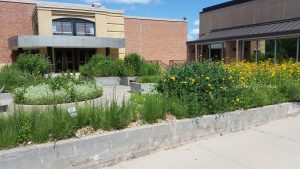
The Early Bloom garden is planted with native species that bloom early in the spring season. The early blooming flowers provide a beautiful location for students to take a few graduation photos. Notice the placard in front with more information about the garden.
Can you think of an ecological benefit provided by early blooming species?
7. Memorial Hall
The building to the south of Hobson Union is Memorial Hall
Memorial Hall is BSU’s first LEED-certified building and includes a variety of energy and conservation techniques that will continue the university’s efforts to reduce its carbon footprint.
BSU has pledged to be carbon neutral. By what year, do we hope to achieve that goal?
8. Solar Transpired Air
Walk around the south side of Memorial Hall and head straight towards Sattghast Hall. Once you reach the back side of Memorial turn left and approach the balcony. From the balcony observe the black box on top of the Lower Hobson Union.
The black box on the roof of the lower union is a Solar Transpired Air installation. This was completed in the fall of 2013 and has an estimated pay off of 12 years. As cold air enters this device, it is naturally warmed up by the suns’ rays. It then enters the buildings heating and ventilation system.
How does this benefit BSU, besides reducing the cost of heating?
9. Butterfly Garden
Walking down the stairs ahead you will see a garden, to the east of you, directly between the Lower Hobson Union and Sattgast Hall.
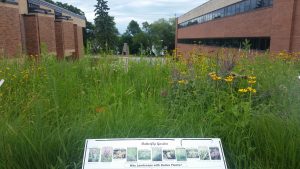
The Butterfly Garden is another place filled with native vegetation on campus. This garden is full of plants that will specifically attract and support Monarch Butterflies. The garden requires little maintenance and it is subjected to a controlled burn every 3 to 4 years in order to replenish nutrients. Notice the placard with more information about the Butterfly Garden.
Do you know of any plant species that are native to this part of northern Minnesota?
10. Benches
If you turn around and look around the open space, you may notice some wooden benches lining the boarder of the area.
These benches were carved from the same White Pine trees as the Wooden Arch mentioned earlier in the tour.
How could these benches be connected to wellness?
11. Shakespeare Garden
Walk down the next set of stairs to your north and look ahead to the northwest. You will notice a small garden to the left of the bridge/walkway.
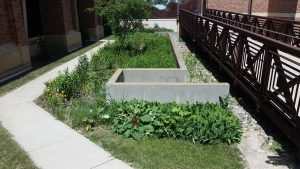
Here is a garden planted with perennial landscaping. This garden requires little maintenance and provides multiple benefits.
Can you think of a reason, besides cutting maintenance costs, why native plantings are so beneficial to their surrounding ecosystem?
If you are touring during the winter months, make note of the bridge and west entry to Bridgeman Hall. If there’s been recent precipitation, you may notice both the bridge and entry area are clear of ice and snow. This is because the campus’ steam heating system runs directly beneath them, effectively keeping them warm enough to stay dry.
How might engineering similarly heated sidewalks across campus improve the sustainability of our built and natural environments on campus?
12. Shoreline Sculpture
Head down the sidewalk going east towards the lake shore. Cross through the lakeside lawn.
By the lake shore, you will notice a sculpture. This sculpture was again carved out of the white pine trees removed from the stadium. This sculpture was created by a local wood carver, Curtis Ingvolstad. There is a placard regarding the artist near the sculpture. Notice that the species depicted on the sculpture represent common wildlife found in North America.
Can you think of a reason why it is important to maintain a diverse number of species?
13.Lake Shore Restoration
Notice all the vegetation along the lake shore.
Along the lake shore, a buffer of native vegetation has been restored and maintained. This buffer zone allows for water filtration and it also prevents erosion of the shoreline. Students for the Environment, a club on campus, has consistently organized lake shore clean up events each semester.
This clearly incorporates which two parts of the BSU Sustainability Model?
14. Sustainability Office
Now go towards the Lower Hobson Union. Go Inside and head straight, past all the tables, until you reach the Sustainability Office (located across from the campus bookstore). Feel free to stop at Einstein Brothers and enjoy a cup of coffee. Make sure to bring a reusable mug for a small discount!
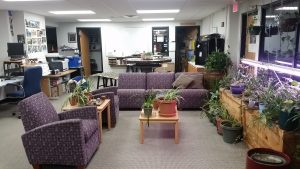
The Sustainability Office engages in many projects around campus, almost all of which are student led projects. The office is a great place to go if you are looking to get involved with campus sustainability or if you are looking for connections with the Bemidji community. Attached to the office is the Free Store. Yes, free. Everything in the store comes from donations and is free to BSU students.
One last question. In what ways does the Free Store promote sustainability?
Thank You for taking the Self Guided Sustainability tour! We hope you enjoyed learning about the ways in which BSU’s campus has been engaging with sustainability as you toured our beautiful campus.
If you are looking for more information please stop by the Sustainability Office.
Could not have completed without the help of: professor emeritus Laurie Desiderato, Sustainability Director Erika Bailey-Johnson, and those who helped us test the tour.
Self-guided tour originally created by: Natasha Lukacs and Kayla McClimek
Edited by: Jordan Lutz
Video tour created by: Jordan Lutz and Erika Bailey-Johnson
Photos taken by BSU staff members.

